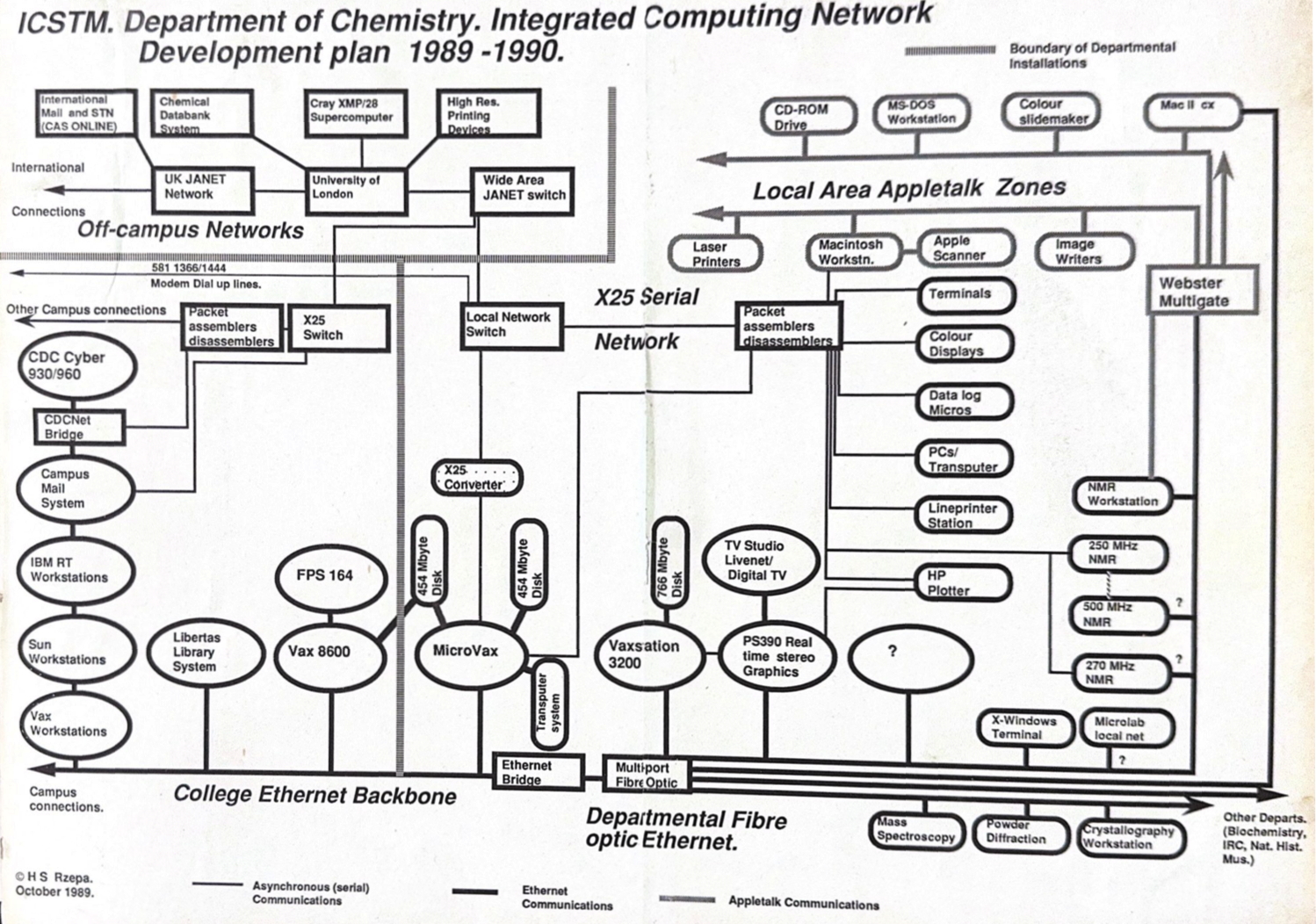In 2023, we very much take for granted that everyone and pretty much everything is online. But it was not always so and when I came across an old plan indicating how the chemistry department at Imperial College was connected in 1989, I was struck by how much has happened in the 34 years since. Nowadays all the infrastructures needed are effectively “built in” to the building when it is constructed and few are even aware of them. But in 1989 that was not at all true.
To introduce the plan I discovered, I will first try to very briefly summarise the evolution of computing and IT infrastructures in a typical university and its departments.
- I will commence around 1960, when most universities started supporting computer “mainframes”. For Imperial college, this was an IBM machine and to access its resources, one had to physically go to the punch room allocated for the purpose. I remind that this is only around 16 years after the Colossus machine started operating in Bletchley park.
- By around 1974, although visiting the “card reader” and the “line printer” was still the best way to access the (single) mainframe, a few select users had access to a “teletypewriter” in their own department. In that year I had started my PhD and I spend quite a lot of time in one such room writing programs and running them, all at the speed of 300 baud. The mainframe was now a CDC 6400 and the terminal was connected to it by a wire running through the heating tunnels.
- By around 1977, the teletypewriter was augmented with a graphics terminal ( Tektronix 4014) which could be used for generating plots, phototypesetting etc. It now operated at 9600 baud, using two line boosters to achieve this effect.
- By about 1981, there were 3-4 terminals in the department, with the number increasing rapidly. They now could be used to access resources around the world. I remember the impact that access to STN International (connecting to Chemical abstracts, called SciFinder nowadays) using such a terminal had on most of the researchers. If the queue was too long, you instead went to the library, where they had also installed such a terminal. One terminal was devoted to word processing, using a simple command line editor, where I wrote my scientific articles. Joy! To support these terminals, we had installed devices called PADs (packet assemblers/disassemblers) running at 19600 baud and supporting the X25 protocol.
- By 1986, the department had already gone through one generation of graphical interface computers (Corvus Concept computers with their own network) which supported early word processing and we were starting to support IBM PCs connected to the PADs by serial lines and the newly released Mac Computers. The latter had their own network (Appletalk) and because these machines were so popular (due to Chemdraw), we started to install an extensive Appletalk network, connected to a core Webster Multigate, which was itself routed to the main College resources using thick wire ethernet. Attached to the Appletalk was our first laser printer! I well remember going to an Apple FTP site and periodically downloading the latest version of their operating system onto a floppy disk so that we could update our Macs and stop them crashing quite so much.
- And so we reach 1989, and the complex networking shown there.“

All this was done within the department, since the central computing resources (the “computing centre”) in 1989 were still focused on the use of mainframes, but starting to devolve into networked workstations (mostly Silicon graphics) by 1991. It would be another decade or so before they full morphed into an IT division and left mainframes behind. By now, networks had become firmly part of the core of their operations.
- But before this, but not shown on this map, chemistry installed in 1999 about 40 WiFi base stations so that people could start to access online resources without the “wires” shown in the above diagram. Mostly in those days Mac computers.
- And with WiFi and then cellular support, came the phones of course.
- I will finish by saying that the current generations of PCs and Macs (which had replaced the workstations) are still “wired” into the department infrastructures, now at speeds of 1 Gbit!
In 2023 a new phenomenon has emerged – software tunnels to allow secure access into the departmental network. We use a product called ZScaler (replacing VPN), and it depends intimately on having a phone to authenticate access. Without that phone and its own 5G access, it is difficult to do anything nowadays.
Quite a lot of change over 34 years!